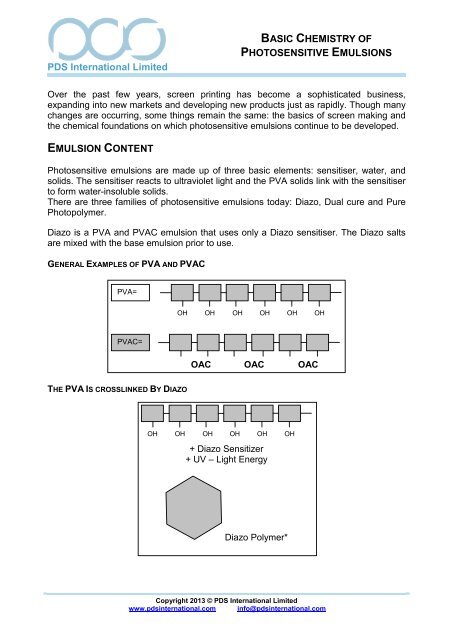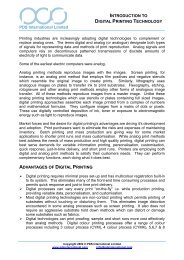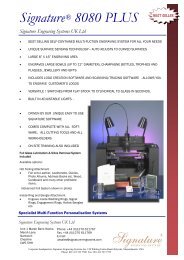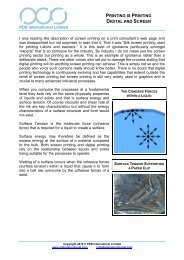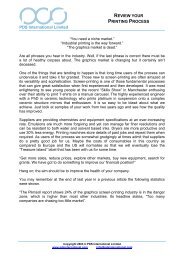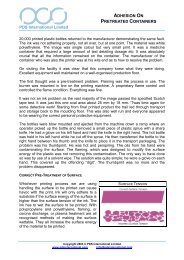Basic Chemistry of Photosensitive Emulsions - PDS International
Basic Chemistry of Photosensitive Emulsions - PDS International
Basic Chemistry of Photosensitive Emulsions - PDS International
You also want an ePaper? Increase the reach of your titles
YUMPU automatically turns print PDFs into web optimized ePapers that Google loves.
<strong>PDS</strong> <strong>International</strong> Limited<br />
BASIC CHEMISTRY OF<br />
PHOTOSENSITIVE EMULSIONS<br />
Over the past few years, screen printing has become a sophisticated business,<br />
expanding into new markets and developing new products just as rapidly. Though many<br />
changes are occurring, some things remain the same: the basics <strong>of</strong> screen making and<br />
the chemical foundations on which photosensitive emulsions continue to be developed.<br />
EMULSION CONTENT<br />
<strong>Photosensitive</strong> emulsions are made up <strong>of</strong> three basic elements: sensitiser, water, and<br />
solids. The sensitiser reacts to ultraviolet light and the PVA solids link with the sensitiser<br />
to form water-insoluble solids.<br />
There are three families <strong>of</strong> photosensitive emulsions today: Diazo, Dual cure and Pure<br />
Photopolymer.<br />
Diazo is a PVA and PVAC emulsion that uses only a Diazo sensitiser. The Diazo salts<br />
are mixed with the base emulsion prior to use.<br />
GENERAL EXAMPLES OF PVA AND PVAC<br />
PVA=<br />
OH OH OH OH OH OH<br />
PVAC=<br />
OAC OAC OAC<br />
THE PVA IS CROSSLINKED BY DIAZO<br />
OH OH OH OH OH OH<br />
+ Diazo Sensitizer<br />
+ UV – Light Energy<br />
Diazo Polymer*<br />
Copyright 2013 © <strong>PDS</strong> <strong>International</strong> Limited<br />
www.pdsinternational.com info@pdsinternational.com
<strong>PDS</strong> <strong>International</strong> Limited<br />
BASIC CHEMISTRY OF<br />
PHOTOSENSITIVE EMULSIONS<br />
PVA CHAIN<br />
OH<br />
OH OH OH O OH O<br />
OH<br />
OH<br />
OH<br />
OH OH OH OH O OH<br />
O<br />
OH<br />
Crosslinking with Diazo increases the molecular weight <strong>of</strong> the PVA materials by linking<br />
the PVA chains. The exposed parts are water insoluble, and will remain as the stencil.<br />
The non- exposed parts remain water soluble and will wash out, forming the image<br />
through which the ink or deposit can pass.<br />
The main use for Diazo cross- linked emulsions is general printing with solvent based<br />
inks.<br />
Dual Cure is an emulsion that uses two light- sensitive materials, usually Diazo and<br />
photopolymers. Dual Cure emulsions require the mixing <strong>of</strong> Diazo salt in the emulsion<br />
But, additionally, are formulated with polymers as well. The general components <strong>of</strong> the<br />
polymer portion <strong>of</strong> the emulsion include acrylate chemicals and a photo initiator. The<br />
following describes the mechanism for photocuring <strong>of</strong> the photopolymer system.<br />
This example is simplified for illustrative purposes:<br />
I I* Initiation<br />
I* + M IM* Chain reaction<br />
IM* + M IMM* Proporgation<br />
IMM* IMMR Termination<br />
I= Initiator M= Acrylate Chemical R= Terminating Ground<br />
Once again, crosslinking the photopolymer increases the molecular weight <strong>of</strong> the<br />
materials, allowing for a rigid defined reproduction <strong>of</strong> the artwork desired. Because <strong>of</strong><br />
their chemistry, dual cure products allow for very sharp reproduction <strong>of</strong> demanding<br />
images.<br />
Copyright 2013 © <strong>PDS</strong> <strong>International</strong> Limited<br />
www.pdsinternational.com info@pdsinternational.com
<strong>PDS</strong> <strong>International</strong> Limited<br />
BASIC CHEMISTRY OF<br />
PHOTOSENSITIVE EMULSIONS<br />
Dual cure emulsions are normally used for a variety <strong>of</strong> applications. Co-solvent, solvent<br />
and water based inks printing require superior image quality along with the durability<br />
required for long print runs with aggressive inks.<br />
PURE PHOTOPOLYMERS<br />
The third class <strong>of</strong> photosensitive emulsions is Pure Photopolymer.<br />
These photopolymer emulsions do not use Diazo as a sensitiser additive. These<br />
emulsions are presensitized and do not require mixing. Pure Photopolymer Chain<br />
The photopolymer is generally PVA with a grafted photosensitive group. The following is<br />
and example <strong>of</strong> pure photopolymer crosslinking:<br />
PURE PHOTOPOLYMER CHAIN<br />
O<br />
H<br />
O<br />
H<br />
O<br />
H<br />
O<br />
H<br />
O<br />
H<br />
O<br />
H<br />
O<br />
H<br />
O<br />
H<br />
+UV Energy<br />
Generally, these emulsions are then formulated with additional non photoactive<br />
polymers for the type <strong>of</strong> printing application needed.<br />
OH<br />
OH<br />
OH<br />
OH<br />
OH<br />
OH<br />
OH<br />
Copyright 2013 © <strong>PDS</strong> <strong>International</strong> Limited<br />
www.pdsinternational.com info@pdsinternational.com
<strong>PDS</strong> <strong>International</strong> Limited<br />
BASIC CHEMISTRY OF<br />
PHOTOSENSITIVE EMULSIONS<br />
LIGHT SENSITIVITY<br />
The aforementioned emulsions are all light sensitive. Each <strong>of</strong> the emulsions undergoes<br />
a change when exposed to UV light. These changes are, as discussed earlier,<br />
crosslinking. The crosslinking or photo polymerization within the emulsion hardens the<br />
emulsion to create a level <strong>of</strong> stencil durability determined by the emulsion thickness,<br />
screen mesh count, exposure time and inherent resistance to solvent.<br />
GENERAL FEATURES<br />
Finally, the following describes the general features <strong>of</strong> the three emulsion families –<br />
Diazo, Dual Cure and Pure Photopolymer. Though manufacturers develop emulsions<br />
differently with specific applications in mind, general comparisons can be made<br />
regarding features <strong>of</strong> these three types <strong>of</strong> photosensitive emulsions.<br />
Diazo emulsions are heat sensitive, require mixing and have a shorter shelf life.<br />
Additionally, they are lower in solids, slower to expose and generally less expensive<br />
than the next two emulsions, dual cure and pure photopolymer.<br />
Dual cure emulsions may be heat sensitive, require mixing and have a short shelf life.<br />
They are higher in solids than diazo emulsions, are more expensive, but have standard<br />
exposures which produce very sharp imaging and durability to all ink types.<br />
Pure photopolymer emulsions, depending on the formulation, generally have higher<br />
solids, have short exposures and a long shelf life. They are more expensive than dual<br />
cure or diazo emulsions, but do not require mixing and are not as sensitive to heat as<br />
the others.<br />
CONCLUSION<br />
As mentioned earlier, the sophistication <strong>of</strong> screen making today has not changed the<br />
basics, and though chemical developments taking place in the industry today have<br />
brought about a variety <strong>of</strong> emulsion products, photosensitive emulsion basics remain the<br />
same.<br />
Copyright 2013 © <strong>PDS</strong> <strong>International</strong> Limited<br />
www.pdsinternational.com info@pdsinternational.com


